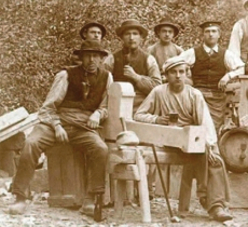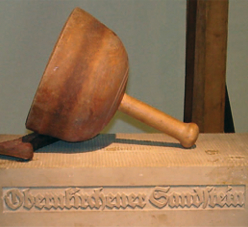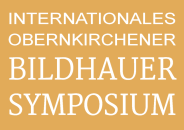SCULPTING HAS TRADITION
As a freak of nature, it has given us the bright yellow, fine-grained sandstone, an excellent material for sculpting.
During the Cretaceous period, 140 Mio years ago, rivers left sediments building this special stone.



More than 850 years ago the stone was used building the Dome of Minden. Buildings in roman and gothic style were created by ruling sovereigns and bishops, piling the dressed stone for castles and monasteries.
Although, it was the building activities of the renaissance that brought the accolade for the Obernkirchen sandstone in the whole North-Europe. Under the influence of the Italian Renaissance, the stone grew to become the most treasured material used for the detailed facades of the castles, churches, town halls or the fine homes of the landed gentry in the Weser district.
During centuries it was known as the "Marble of North Germany" and without competition talking about the art of funerary monuments. On the Jewish-Sephardic cemetery in Altona, which in near future could be listed as a UNESCO World Heritage Site, about 5000 of the 6000 well-kept tombstones are from Obernkirchen.
As a result of the immense building activity, the number of qualified stonemasons in Obernkirchen grew and the artistic blossom was well nourished in numerous mason workshops. Outstanding sculptor personalities, such as Hans Wulff (Town church and Castle gate in Bückeburg) and Georg Tribbe (Epitaphs for the Dukes of Celle).
In the monastery Church of St. Mary (Obernkirchen) you will find an early Baroque, mannerist baptismal font made by Hans Wulff and the alabaster-marble-epitaph made by Georg Tribbe, in the so-called earmuscle-cartilage stile. And by the way, the sandstone table next to culture cafe „Trafohaus“ is made from a pillar base of the Roman basilica and the original socket of the baptismal font of the church.
Over centuries the Obernkirchen population was dealing with an ambivalent relationship to their sandstone. The sandstone was a stable, economical foundation, - on the other hand, working with the stone meant a decrease in life expectancy.
Silicosis often caused the death of the stonemason in the age of 36 - 38, and not till the implementation of powerful exhaust equipment this scourge of the stone masons could be eliminated.
Until today the best sandstone is won from the Bückeberg mountain ridge. Refined by the hands of guild craftsmen and talented artists the Obernkirchen Sandstone has given the beautiness and commanding presence to numerous domes, castles, town halls as well as many masterpieces of art.
Following the Sculpture Path, you will also reach the Stone Mason's Place with the „Wesling Obernkirchener Sandstein GmbH“ company buildings.
During the medieval times, the sandstone quarries were exhausted by the monastery building lodge. So after the Reformation, the Count of Schaumburg rented out the quarries to the masters of the Obernkirchen Mason Guild. In 1870, when the guild was terminated, the masons grouped a stock corporation.
Today the company produces material for surfaces, delivers sandstone for the permanent construction site of the Cologne Dome and takes over restoration works, as well.
In the local museum, "Berg- und Stadtmuseum, Obernkirchen" you will find a very informative exhibition, telling and showing the history of the sandstone and the Obernkirchen Stone Mason Guild.
Well informed from here you can start your personal encounter with more than 50 pieces of art placed along the Sculpture Path in town and open landscape.



